Because technology change fails without people change.
CPQ migration is the strategic transfer of existing quote-to-cash processes, pricing intelligence, and customer data from legacy systems to modern configure price quote platforms while maintaining business continuity. Unlike standard data imports, CPQ migration preserves institutional knowledge, embedded business logic, and approval workflows that have evolved over years of sales operations.
CPQ migration represents the most overlooked component in change management strategies, yet it determines success or failure more than technology selection. Recent industry data shows that 79% of manufacturers still struggle with quoting quality after CPQ implementation, while MGI Research reveals 40% of first-time CPQ implementations fail to deliver expected business outcomes. Unlike simple data imports, CPQ migration resembles an organ transplant—requiring careful preservation of business logic, institutional knowledge, and workflow patterns while maintaining uninterrupted revenue operations. Organizations that master migration continuity achieve 65% faster adoption rates and maintain productivity throughout deployment.
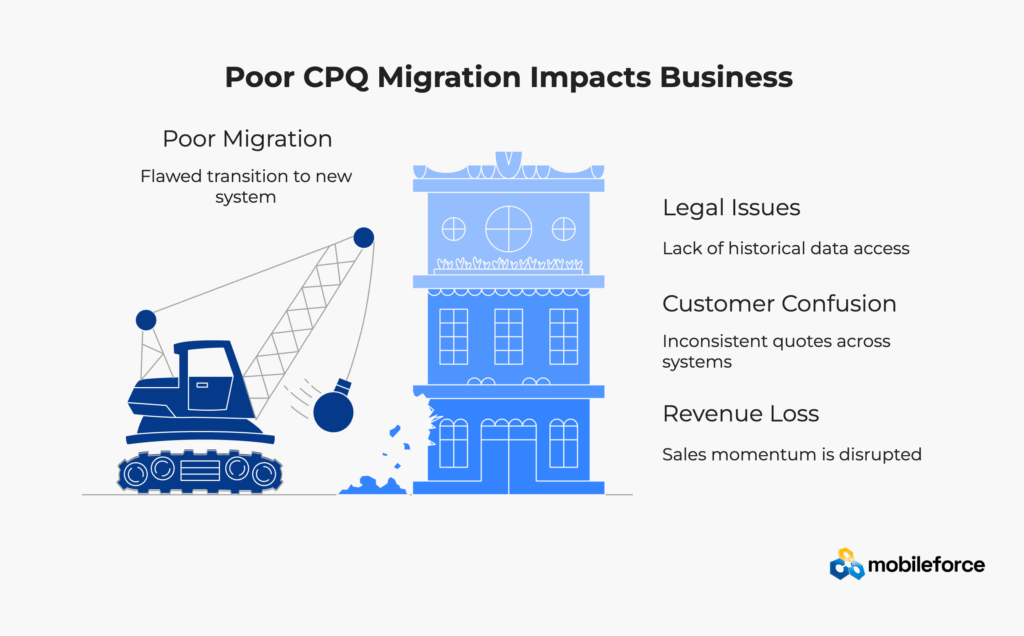
“We spent six months planning our CPQ rollout, but nobody asked what happens to the 47 quotes sitting in our pipeline when we flip the switch.” This confession from a VP of Sales captures one of the most overlooked aspects of CPQ change management—migration isn’t just about data transfer. It’s about business continuity during transformation.
When evaluating CPQ vendors, organizations often focus on features, pricing, and implementation timelines while overlooking migration complexity. This oversight explains why many companies struggle with CPQ software adoption despite choosing technically superior platforms. The best CPQ solutions for your organization must include robust migration capabilities that preserve business operations throughout the transition process.
Ready to ensure seamless business continuity during your CPQ migration? Schedule a consultation to explore proven migration strategies that protect revenue operations.
Think of CPQ migration like an organ transplant, not a simple data import. You’re not just moving information from one system to another—you’re transplanting the lifeblood of your sales operation while keeping the patient alive and healthy.
The complexity runs deeper than most teams realize. That Excel template your top performer has refined over three years contains pricing logic, approval shortcuts, and customer-specific configurations that took months to perfect. The manual quoting process your team uses for complex deals includes judgment calls, escalation paths, and relationship nuances that can’t be captured in standard data fields.
The Hidden Architecture of Existing Processes
Every organization has invisible infrastructure built around their current quoting methods. Sales reps know which customers always negotiate on delivery terms. Finance knows which product combinations trigger margin reviews. Operations knows which quotes typically convert and which ones are just competitive intelligence gathering.
This institutional knowledge doesn’t migrate with your data. Here’s the challenge—most of it isn’t even documented. It exists in people’s heads, in forwarded email chains, and in those “special case” folders everyone maintains but nobody talks about during requirements gathering.
Recent analysis from Tacton’s 2025 State of Manufacturing Report reveals that 43% of manufacturers still use spreadsheets for CPQ processes, with nearly half of Excel users reporting satisfaction with current quoting despite high error rates. This satisfaction masks the complexity of embedded business logic that must be preserved during migration.
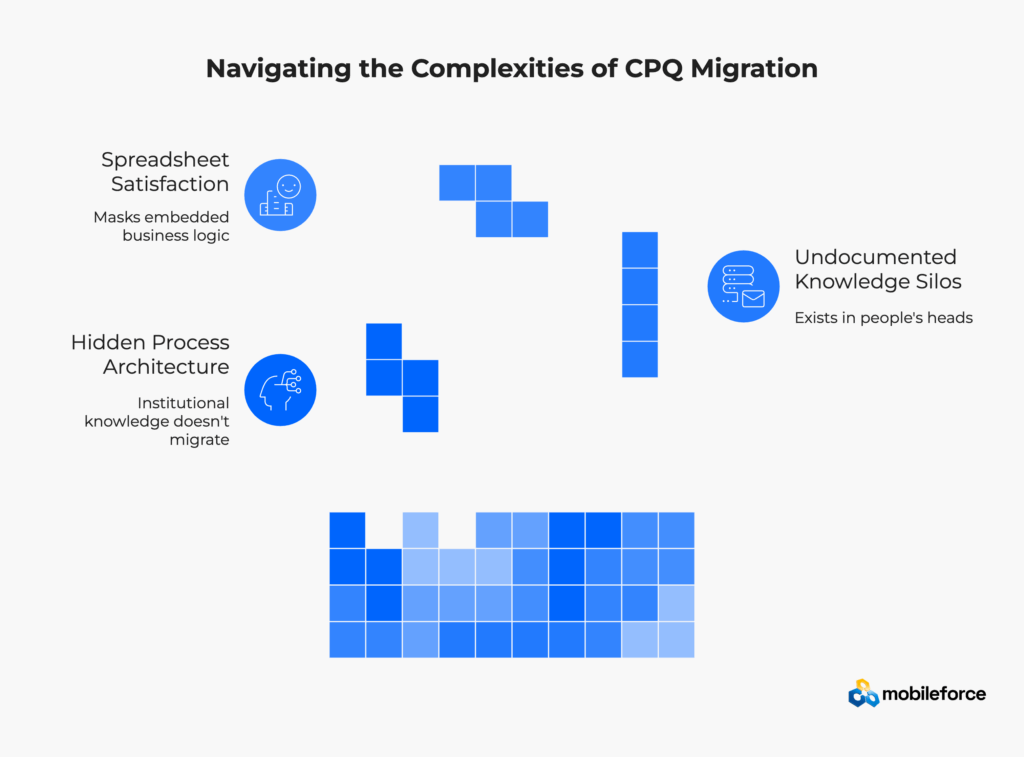
Revenue operations don’t pause for software deployments. While implementation teams focus on go-live readiness, sales teams have quotas to hit and deals to close. That creates fundamental tension between transformation needs and uninterrupted revenue generation.
Consider what happens during typical CPQ migration. You have quotes in various stages—some waiting for approvals, others pending customer decisions, still others halfway through revision cycles. Your legacy system might be a combination of Excel templates, email chains, and manual calculations. How do you handle the transition without losing deals or confusing customers?
Forrester research indicates that 52% of B2B buyers feel frustrated by inconsistent or slow quoting processes. Migration periods amplify this frustration when customers receive quotes in different formats or experience delayed responses during system transitions.
The financial impact extends beyond immediate revenue loss. Customer confusion during migration can damage long-term relationships, particularly with strategic accounts that expect consistent service experiences. Sales team productivity often decreases during transition periods as representatives struggle with unfamiliar systems while maintaining existing commitments.
Most teams pick a “cutover weekend” and hope for the best. But this approach ignores B2B sales cycle realities, which don’t respect implementation timelines. Manufacturing companies might have quotes pending for months due to complex approval processes. Service organizations often maintain active negotiations spanning multiple quarters.
Organizations comparing CPQ platforms should prioritize vendors offering comprehensive migration support and business continuity planning. The best CPQ software providers understand that migration complexity often determines implementation success more than feature functionality.
Transform your migration strategy from risk to competitive advantage. Contact our team to discuss business continuity approaches tailored to your industry.
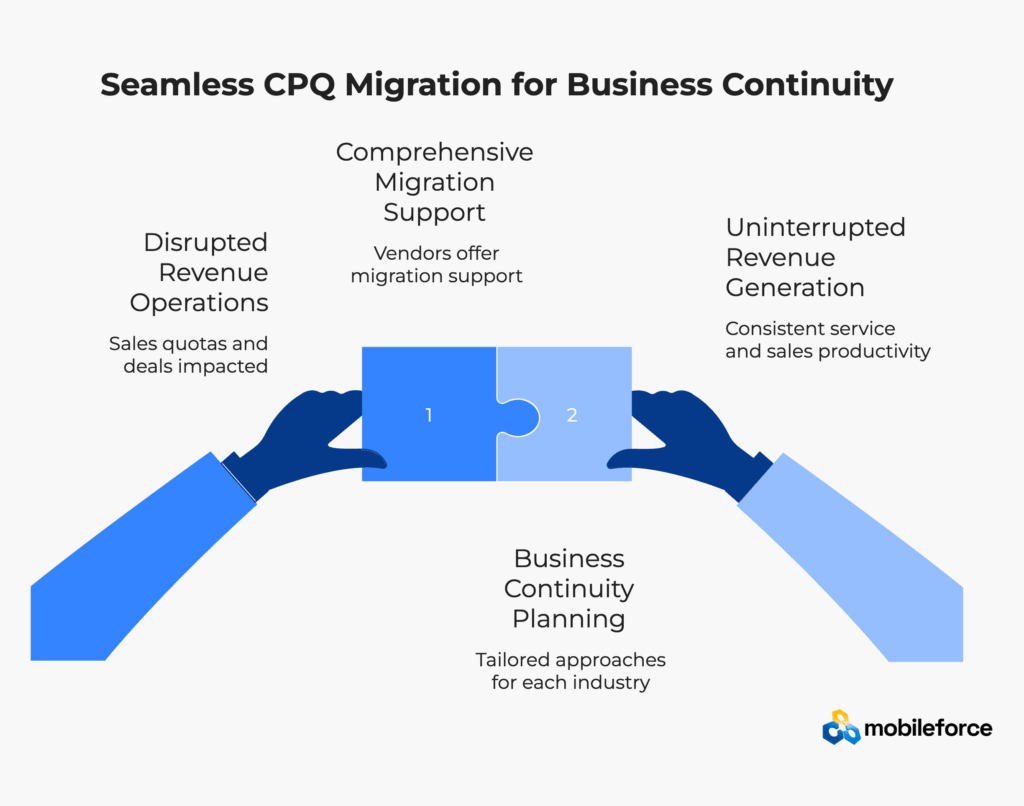
CPQ migration involves more than moving customer names and product descriptions. You’re migrating business logic that might be embedded in Excel formulas, approval workflows, discount matrices, and pricing rules that have evolved organically over years.
That spreadsheet your team uses for complex manufacturing quotes probably contains IF-THEN statements representing years of learned pricing strategies. The email approval chain for non-standard deals reflects organizational hierarchies and decision-making patterns that formal org charts don’t capture.
New CPQ systems often use different data structures than legacy processes. Your old system might group products by sales territory, while the new one organizes by product family. Legacy discount calculations might be percentage-based, while the new system uses absolute dollar amounts.
These aren’t just technical mapping exercises. They represent fundamental differences in how business logic gets executed. Converting percentage discounts to dollar amounts sounds simple until you realize that existing percentages were calculated based on list prices that don’t exist in the new system.
According to industry analysis, even off-the-shelf CPQ solutions require customization for full system integration. When building things in-house, technical teams become responsible for developing and maintaining those customizations throughout the organization’s growth.
Migration Challenge | Legacy Approach | Modern Solution |
Business Logic Transfer | Manual conversion with data loss | No-code configuration enabling business user control |
Quote Format Compatibility | Accept inconsistency during transition | Template mapping with customer communication |
Approval Workflow Continuity | Parallel manual processes | Automated workflow translation |
Historical Data Access | Export to static files | Integrated legacy data access |
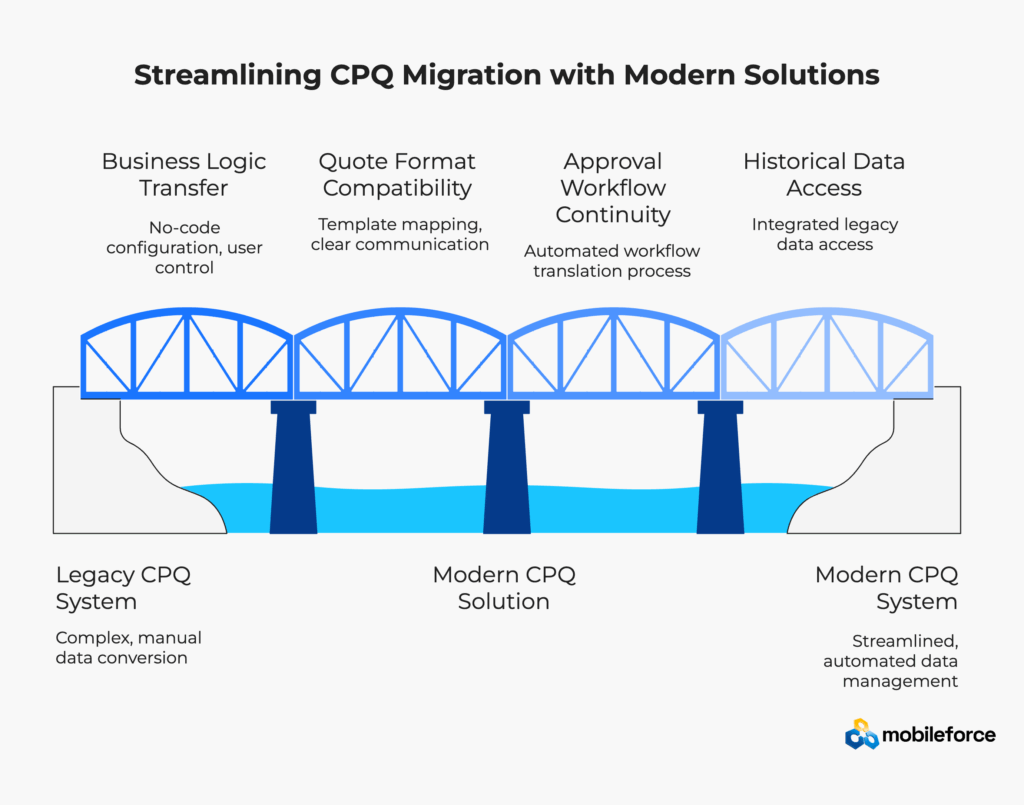
Organizations often forget that migration affects more than quote creation. Historical reporting, trend analysis, and performance metrics all depend on consistent data structures over time.
Your Q4 reporting might need to include quotes created in both old and new systems. Year-over-year comparisons become complicated when data structures change mid-year. Commission calculations might depend on historical quote data that now exists in different formats.
Some organizations maintain parallel systems during transition periods, creating ongoing maintenance overhead and data synchronization challenges. Others attempt to convert all historical data to new formats, often losing nuance and context in the translation.
The challenge extends beyond immediate reporting needs. Legal requirements, audit processes, and customer service inquiries create indefinite dependencies on historical quote information. A customer might call three years after migration asking about pricing details from a legacy quote, requiring access to information in its original format and context.
Ensure comprehensive data continuity throughout your migration journey. Explore Mobileforce’s approach to maintaining historical data access while advancing to modern CPQ capabilities.
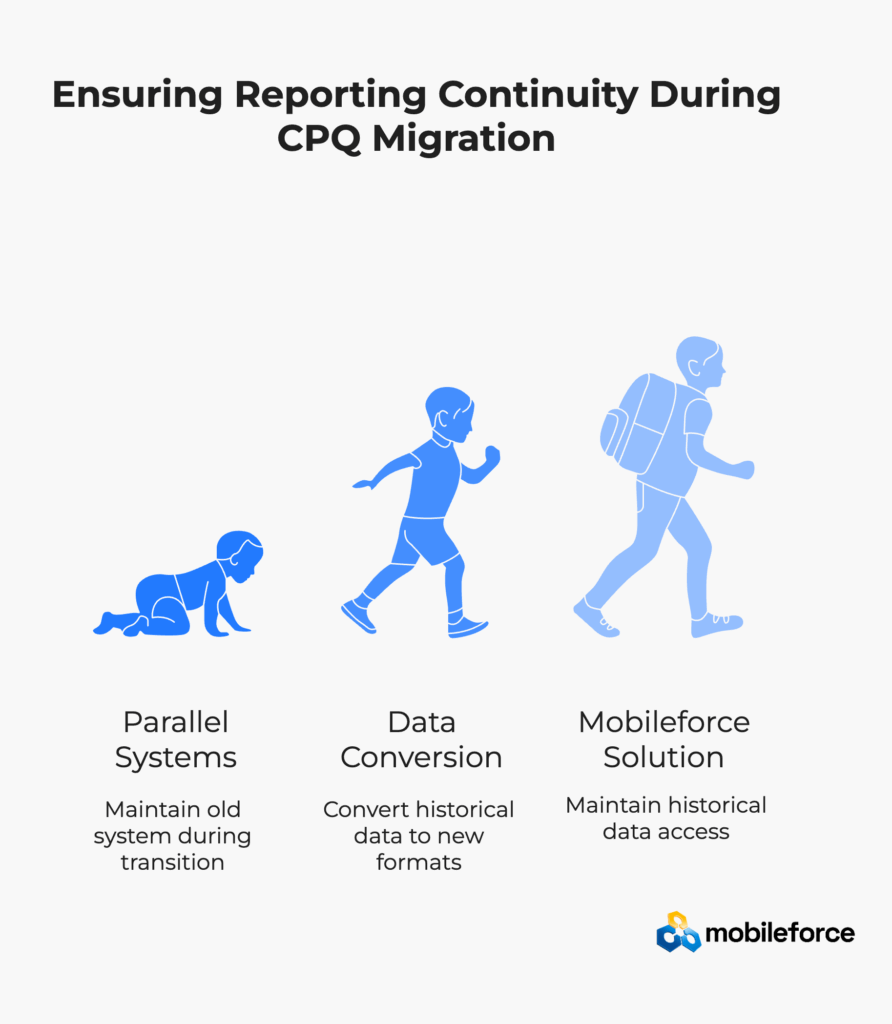
Instead of complete system cutover, successful organizations often run parallel processes during migration periods. New quotes use the new system, while existing quotes continue in legacy processes until completion. This approach requires more administrative overhead but prevents deal disruption.
The key lies in establishing clear handoff protocols. Which system handles quote revisions? How do you manage approvals that span both systems? What happens when customers request changes to quotes created in the legacy system?
Organizations using Mobileforce’s migration capabilities can maintain seamless operations by leveraging integration tools that allow real-time data synchronization between systems during transition periods.
Before migration begins, conduct thorough audits of existing quote inventory. Categorize quotes by complexity, stage, and strategic importance. Some deals might be worth converting to new systems, while others should complete in legacy processes.
This audit often reveals process inefficiencies that migration can address. Quotes pending for months might indicate approval bottlenecks that new workflows can eliminate. Complex configurations requiring manual calculations might benefit from automated CPQ logic.
According to implementation data, organizations conducting comprehensive pre-migration audits achieve 45% faster adoption rates and maintain 90% productivity levels throughout transition periods.
Migration success depends heavily on administrative capabilities within new systems. Can your admin team easily import existing quote templates? Does the system provide tools for bulk data conversion? Can you configure approval workflows that mirror existing organizational hierarchies?
Many CPQ platforms excel at creating new quotes but provide limited tools for migrating existing work. This gap often forces organizations to choose between losing work-in-progress or maintaining expensive parallel systems longer than planned.
Modern platforms like Mobileforce offer comprehensive admin toolsets that enable business users to manage migration processes without extensive IT dependency, accelerating transition timelines while maintaining data integrity.
When purchasing CPQ software, organizations should evaluate admin capabilities during vendor demonstrations. Request specific migration scenarios that match your business complexity. The most cost-effective CPQ solutions provide business-friendly tools for managing data transfer, workflow configuration, and user permission management without requiring expensive consulting services.
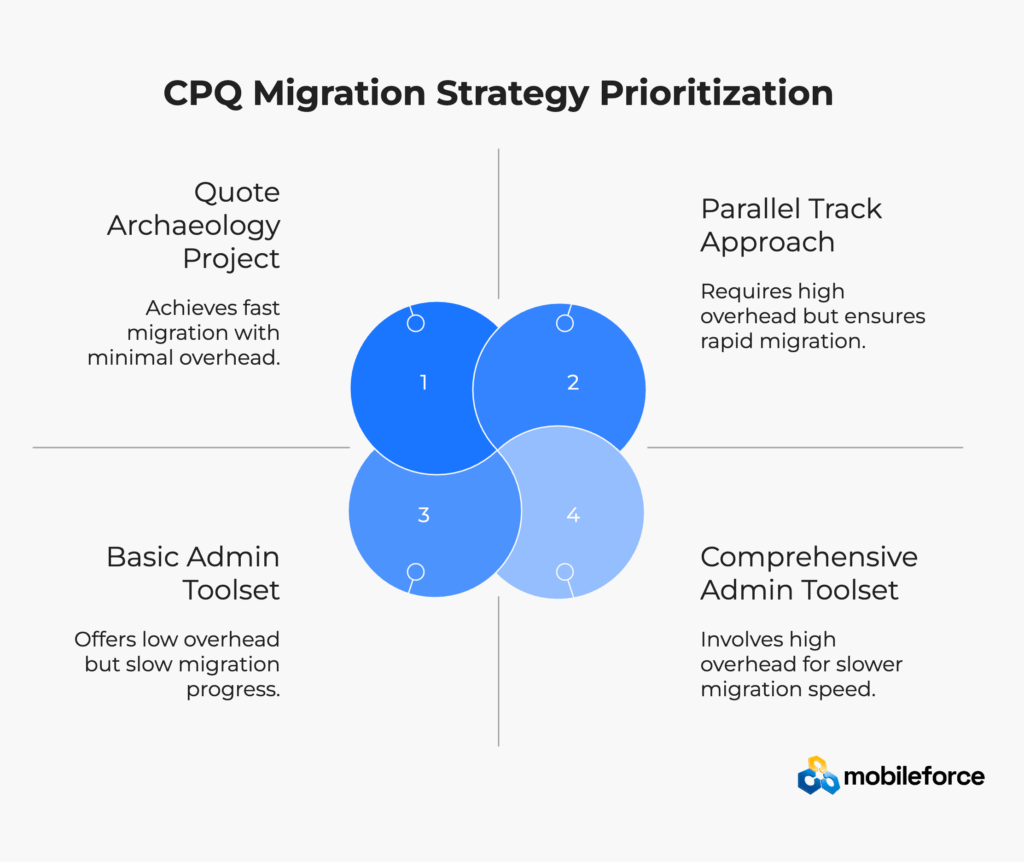
Migration planning should begin during system evaluation, not after platform selection. Include migration requirements in vendor assessment criteria. Test data conversion tools during proof-of-concept phases. Map existing approval workflows to new system capabilities before committing to implementation timelines.
Change management communications should address migration explicitly. Sales teams need to understand what happens to their existing pipeline. Customers should receive clear communication about any changes to quote formatting or approval processes. Finance teams need guidance on how migration affects reporting and commission calculations.
The most successful migrations involve creating dedicated communication channels for migration-related questions and concerns. This prevents confusion from derailing broader change management initiatives while ensuring stakeholders receive accurate information about transition processes.
During migration periods, users need to operate effectively in both old and new environments. Training programs should address this reality rather than focusing exclusively on new system capabilities.
Sales representatives might need to know how to access historical quotes in legacy systems while creating new ones in CPQ platforms. Approvers might need to monitor multiple systems for pending requests. Customer service teams might field questions about quotes created in different systems with different formatting.
Organizations using comprehensive field service capabilities can maintain consistency across all customer touchpoints during migration periods, ensuring service quality doesn’t suffer during system transitions.
Migration Phase | Business Focus | Timeline | Success Metrics |
Discovery & Audit | Quote inventory analysis | 2-4 weeks | 100% quote categorization |
Parallel Operations | Dual system management | 8-12 weeks | Zero revenue disruption |
Transition Management | Workflow optimization | 4-6 weeks | 95% user adoption |
Legacy Retirement | Data archival strategy | 2-3 weeks | Complete historical access |
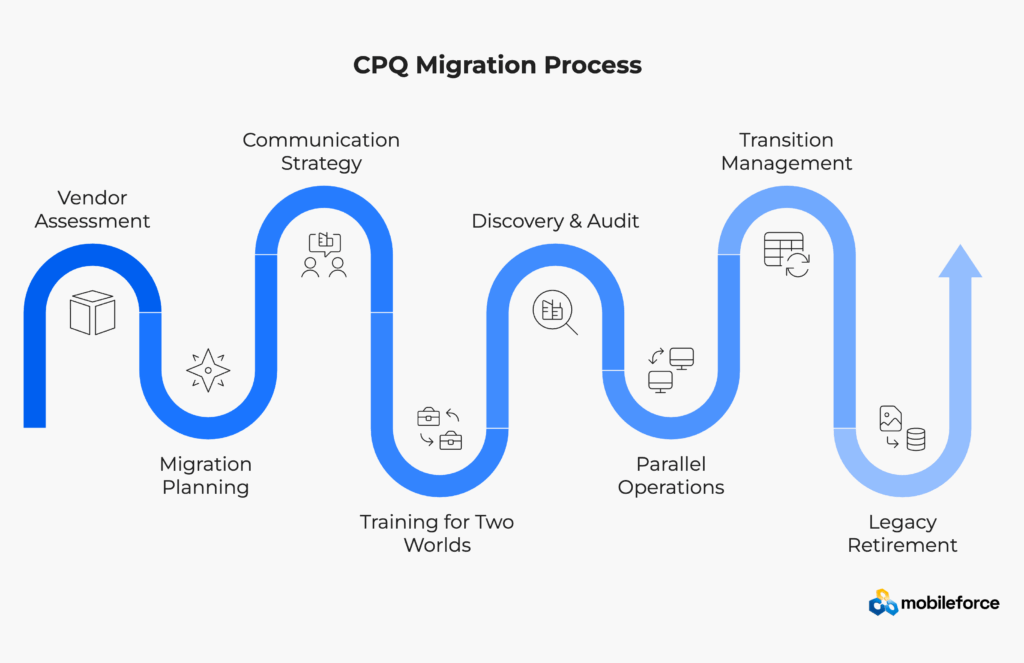
Migration effects persist long after go-live dates. Historical reporting requests, audit requirements, and customer inquiries about old quotes continue indefinitely. Organizations need sustainable approaches for accessing legacy data without maintaining expensive system infrastructure.
Some companies export historical data to simplified databases or document management systems. Others negotiate extended access periods with legacy system vendors. The key involves planning for these long-tail requirements during migration design rather than addressing them reactively.
Organizations that master CPQ migration often discover competitive advantages beyond system functionality. The discipline required for successful migration—process documentation, data cleanup, workflow optimization—creates operational capabilities that benefit broader business initiatives.
Migration forces organizations to confront inefficiencies they might otherwise ignore. Redundant approval steps become obvious when mapping workflows to new systems. Data quality issues that were manageable in small-scale processes become critical when scaling to enterprise platforms.
The institutional knowledge captured during migration often proves more valuable than the technology itself. Organizations emerge with documented processes, clear governance structures, and optimized workflows that serve them regardless of future system changes.
Ready to turn migration from implementation risk into competitive advantage? Schedule a demo to explore how Mobileforce’s comprehensive migration approach protects your revenue operations while accelerating transformation.
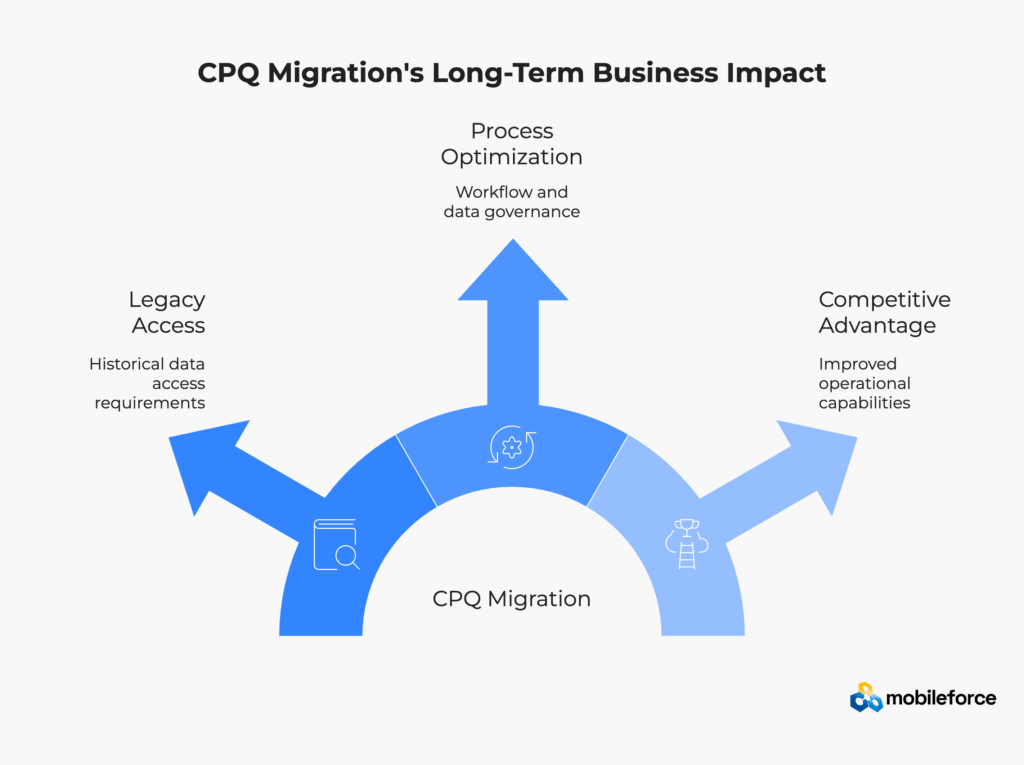
Traditional CPQ platforms often provide limited migration support, forcing organizations to develop custom solutions or accept data loss during transitions. Mobileforce’s approach to migration management addresses these challenges through comprehensive toolsets designed specifically for business continuity.
Unlike platforms requiring extensive technical development for migration tasks, Mobileforce’s no-code configuration capabilities enable business users to manage migration processes directly. This approach accelerates timeline execution while ensuring domain expertise guides migration decisions rather than technical constraints.
Sales operations teams can directly modify quote templates, pricing rules, and approval workflows during migration periods without requiring IT tickets or development cycles. This capability proves especially valuable when discovering edge cases or business logic that wasn’t captured during initial migration planning.
Rather than forcing organizations to maintain parallel systems or export historical data to static formats, Mobileforce provides integrated access to legacy information alongside current operations. This approach eliminates long-term maintenance overhead while ensuring complete historical continuity.
Customer service representatives can access historical quotes regardless of which system originally created them. Reporting tools can analyze trends across migration periods without requiring complex data reconciliation processes. Audit processes can access complete quote histories without maintaining expensive legacy system access.
The comprehensive integration capabilities ensure that historical data remains accessible through modern interfaces while new operations benefit from advanced CPQ functionality.
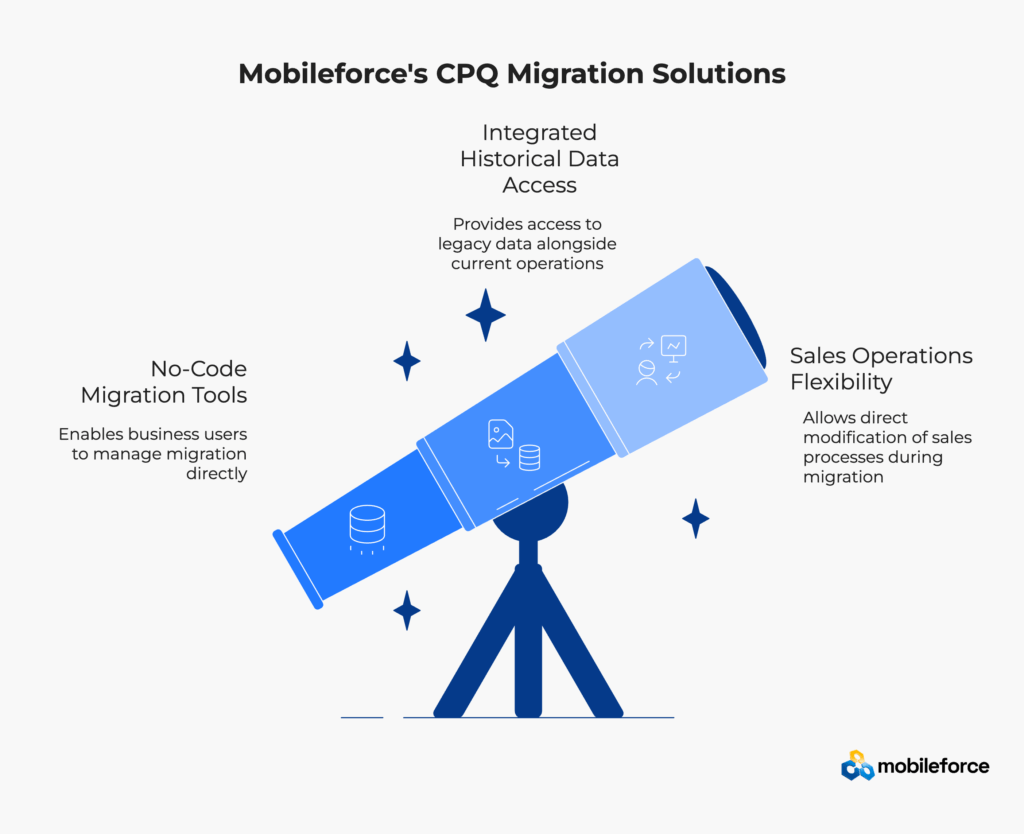
CPQ migration represents far more than a technical hurdle to overcome—it’s an opportunity to transform your organization’s approach to revenue operations while building capabilities that serve long-term growth. The difference between migration success and failure lies not in technology selection, but in treating migration as a strategic business initiative that preserves institutional knowledge while advancing operational capabilities.
The evidence overwhelmingly supports comprehensive migration planning. Organizations that invest in proper migration strategies achieve 65% faster adoption rates, maintain productivity throughout transition periods, and emerge with documented processes that benefit future initiatives.
Modern CPQ platforms like Mobileforce are specifically designed to support effective migration through no-code configuration capabilities, comprehensive integration tools, and business-friendly administrative interfaces. These capabilities enable organizations to maintain business continuity while accessing advanced CPQ functionality that drives competitive advantage.
The competitive landscape increasingly rewards organizations that can rapidly adapt their go-to-market processes in response to market conditions. CPQ systems provide the foundation for this agility, but only when implemented through comprehensive migration approaches that preserve business knowledge while enabling transformation.
Don’t let migration be the component that derails your CPQ transformation. Build it into your change management strategy from day one, and watch it become a competitive advantage rather than an implementation risk.
Ready to transform your CPQ migration from implementation risk into competitive advantage? Contact Mobileforce today to discover how our comprehensive migration approach protects your revenue operations while accelerating your transformation success.
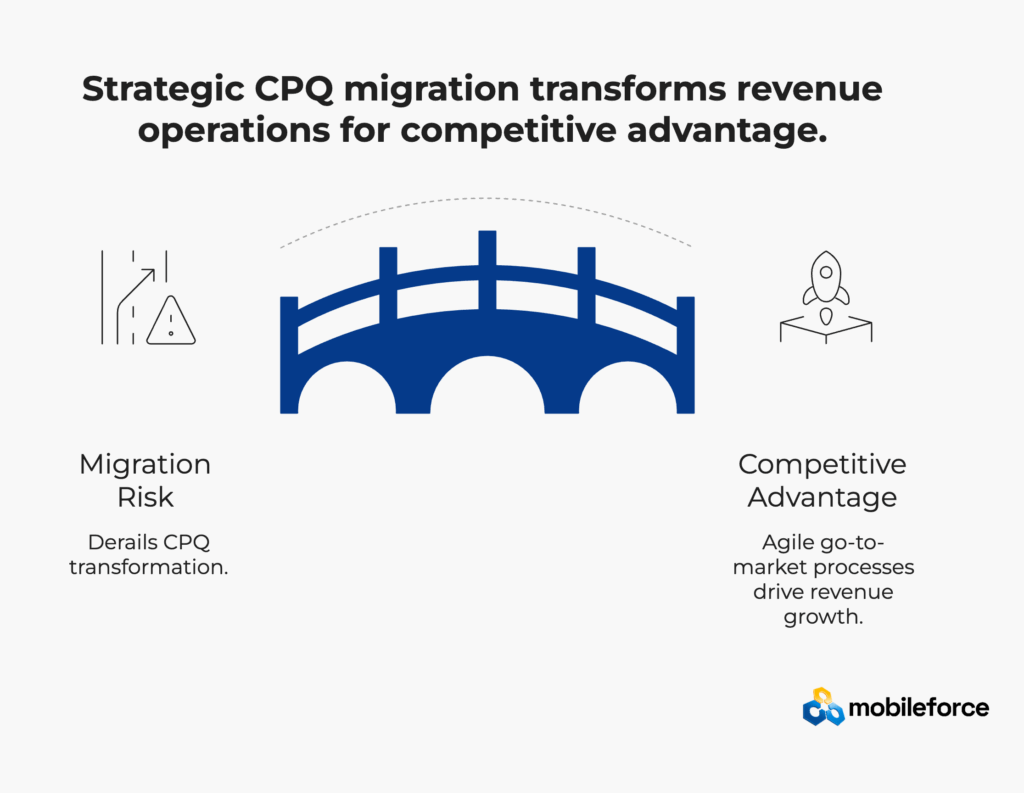
CPQ migration timelines vary significantly based on data complexity and business continuity requirements. Organizations using modern platforms like Mobileforce typically complete migration in 4-8 weeks, compared to 12-18 months for traditional enterprise platforms. The key difference lies in no-code configuration capabilities that enable business users to manage migration processes directly rather than requiring extensive custom development.
Successful migration follows this timeline framework:
Business continuity requires strategic management of in-flight quotes throughout migration periods. The most effective approach involves parallel track operations where existing quotes complete in legacy systems while new quotes utilize modern CPQ capabilities.
Mobileforce’s migration approach enables seamless handoff protocols that prevent revenue disruption. Quote revisions can be handled through automated translation between systems, while customer communications remain consistent regardless of underlying system changes.
Organizations should establish clear protocols for quote modifications, approval workflows spanning both systems, and customer service responses to questions about formatting changes.
Complex pricing logic presents the most significant migration challenge because it often exists as undocumented institutional knowledge rather than formal system configurations. Excel formulas containing years of pricing intelligence must be translated into new system logic without losing nuance or accuracy.
No-code configuration platforms address this challenge by enabling business users to directly implement pricing logic during migration. Sales operations teams can test and refine pricing rules in real-time, ensuring accuracy before full deployment.
The key involves comprehensive business logic documentation during migration planning, followed by iterative testing with actual historical quotes to validate translation accuracy.
The most common migration mistakes include treating migration as a purely technical exercise, underestimating business continuity requirements, and failing to plan for long-term historical data access.
Critical mistakes to avoid:
Organizations should prioritize business continuity over technical perfection, ensuring revenue operations continue smoothly throughout migration periods.
Data quality management requires comprehensive auditing, cleansing, and validation processes before migration begins. Organizations should establish data governance policies, create standardized naming conventions, and implement validation rules to prevent future quality degradation.
The most effective approach involves progressive data cleanup during parallel operations rather than attempting comprehensive cleansing before migration starts. This allows real-world testing to identify quality issues while maintaining business operations.
Mobileforce’s integration capabilities include data validation tools that identify inconsistencies and suggest corrections during migration processes, ensuring high-quality data in new systems.
Integration complexity often exceeds initial expectations, particularly for data synchronization between CPQ systems and existing CRM, ERP, and inventory management platforms. Common challenges include data format inconsistencies, performance issues under production loads, and maintenance overhead for custom integrations.
Organizations should prioritize CPQ platforms with pre-built integration capabilities and API-first architectures to minimize these challenges. Mobileforce offers native integrations with major CRM and ERP platforms, reducing implementation complexity and time-to-value.
Testing integration performance with production data volumes during proof-of-concept phases helps identify potential bottlenecks before full migration begins.
Legacy system access requirements extend indefinitely due to legal, audit, and customer service needs. Rather than maintaining expensive legacy system infrastructure permanently, organizations should plan integrated historical data access within new CPQ platforms.
The most cost-effective approach involves migrating historical data to accessible formats within new systems while retiring legacy infrastructure. This provides indefinite access to historical information without ongoing maintenance costs.
Some organizations negotiate extended read-only access to legacy systems for 2-3 years while historical data integration is completed, providing backup access during transition periods.
Administrative capabilities within CPQ platforms often determine migration success more than core quoting functionality. Migration requires extensive configuration mapping, data validation, workflow translation, and user permission management.
Platforms with comprehensive admin toolsets enable business users to manage migration processes directly, accelerating timelines while ensuring business logic accuracy. Mobileforce’s CPQ admin capabilities provide business users with direct control over migration processes without requiring technical expertise.
Organizations should evaluate admin toolset capabilities during platform selection, ensuring migration requirements can be managed through business-friendly interfaces rather than requiring ongoing IT dependency.
User training during migration requires dual-system competency as users must operate effectively in both old and new environments during transition periods. Training programs should address this reality rather than focusing exclusively on new system capabilities.
The most effective approach involves just-in-time training that addresses specific scenarios as they arise rather than comprehensive upfront training on all system capabilities. This reduces training burden while ensuring users receive relevant instruction when they need it.
Microlearning approaches combined with internal champion networks prove most effective for supporting users during migration periods, providing peer-to-peer support that formal training programs cannot match.
What metrics should you track during CPQ migration?
Migration success requires balanced scorecards tracking both technical progress and business impact. Key metrics include migration completion percentage, business continuity indicators, user adoption rates, and system performance measurements.
Essential migration metrics:
Organizations should establish baseline measurements before migration begins, enabling accurate progress tracking and early identification of issues requiring attention.
Ready to transform your CPQ migration from implementation risk into competitive advantage? Contact Mobileforce today to discover how our comprehensive migration approach protects your revenue operations while accelerating your transformation success.